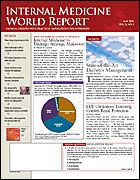New Criteria Proposed for PSA Velocity in Younger Men
From the Prostate Cancer Symposium
SEATTLE—You may need to reconsider what you regard as a safe and normal prostate-specific antigen (PSA) level in men aged 40 to 60 years. Data presented at the 2006 Prostate Cancer Symposium indicate that more cancer could be detected in younger men if some of the current diagnostic criteria were adjusted by age.
PSA levels are used by physicians to determine the need for biopsy. The current threshold for the rate of increase (PSA velocity) is 0.75 ng/mL per year; thus if a man’s PSA levels rise >0.75 in 1 year, he should be considered for biopsy. Now, a review of the medical records of nearly 12,000 men has shown that this criterion could prevent physicians from detecting prostate cancer in younger men.
“In the past few years, 60 or younger has become the peak age for prostate cancer diagnosis. Using PSA velocity makes it more likely that we will detect cancers in men of this age,” said lead investigator Judd Moul, MD, chief of urologic surgery, Duke University Medical Center, Durham, NC.
Men who had ≥1 PSA value in their medical record were recruited for the study and were divided into 3 age-groups: <60, 60 to 70, and >70 years.
“In the past few years, 60 or younger has become the peak age for prostate cancer diagnosis. Using PSA velocity makes it more likely that we will detect cancers in men of this age.”
—Judd Moul, MD
The data showed that PSA levels rose more slowly in men aged <70 years. Although the current threshold (0.75 ng/mL) was an accurate predictor of prostate cancer in men aged ≥70 years, Dr Moul believes that new optimal age-adjusted thresholds should be set at 0.4 ng/mL per year for men younger than 60 and at 0.6 ng/mL per year for older men (aged 60-70).
Using the lower thresholds, Dr Moul and colleagues were able to identify an additional 9% of men <60 years and 3% of men aged 60 to 70 years who had prostate cancer that was not identified by other criteria.
Although a lower PSA velocity can guard against underestimating the risk of prostate cancer, it may also identify some prostate cancers that do not require treatment. Nevertheless, identifying more cancers in men younger than 60 can have an important impact on their quality of life.
“Prostate cancer in young men is not more aggressive, but guys in their 40s and 50s are so young that they have an additional 30 to 40 years to be concerned with this problem,” said Dr Moul. “That’s why we recommend an active treatment approach in young­er men.”
To develop a more accurate picture of PSA levels over time, Dr Moul recommends baseline testing at age 40, especially for men at increased risk for prostate cancer (ie, black men, positive family history). Those at average risk should have baseline testing at age 45. If the PSA value is ≤1.5 ng/mL, subsequent screening can be done every 5 years. Values >1.5 ng/mL warrant annual screening.
One of the study limitations was the use of PSA values from urology patients rather than from the general public. Also, the impact of abnormal digital rectal examinations was not considered, because such examinations identified only 4.7% of prostate cancer cases.
IMWR
“Baby boomers, who are well informed, may be asking their primary care doctor about the PSA,” Dr Moul told . “Physicians will have to use the test smartly.”
KEY POINTS
Adjust PSA velocity by age to determine need for biopsy.
PSA levels rise more slowly in men <70 years.
The PSA velocity threshold for men <60 years should be 0.4 ng/mL per year; for those aged 60-70 years, it is 0.6 ng/mL per year.
